by Briscoe White | Jun 26, 2015 | Gardening, Miscellaneous, Pests and Problems |
These unattractive enemies have taken over my squash, and I am spending much of my time and energy in a war against them. Squash Beetles ~ nasty little things that suck the life out of the plants I’ve been nurturin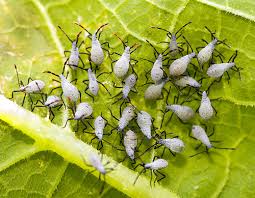 g since I first put seed to soil in mid March. You name it, I’ve tried it : Diatomaceous Earth, Rotonone Powder, Pyrethrum Spray … even the time consuming and not so pleasurable task of hand picking these creatures off of my squash leaves. I’ve read articles, researched remedies and honestly, felt a lot of stress that is not a usual part of my post-spring mentality. This ‘war’ runs against all of the reasons that I love growing plants; growing puts me back in touch with the natural rhythms and harmony of the natural world. I like working WITH nature, not against it. But, this is an on-going war and I refuse to surrender.
g since I first put seed to soil in mid March. You name it, I’ve tried it : Diatomaceous Earth, Rotonone Powder, Pyrethrum Spray … even the time consuming and not so pleasurable task of hand picking these creatures off of my squash leaves. I’ve read articles, researched remedies and honestly, felt a lot of stress that is not a usual part of my post-spring mentality. This ‘war’ runs against all of the reasons that I love growing plants; growing puts me back in touch with the natural rhythms and harmony of the natural world. I like working WITH nature, not against it. But, this is an on-going war and I refuse to surrender.
This whole unfortunate situation brings me back to the reason that I LOVE growing herbs and making an herb spiral. Although they are not 100% free of worries, herbs have VERY FEW natural ‘enemies’. My greenhouses are filled with over 150 different varieties of herbs, but I can safely say that not much of my time is spent ‘fighting’ or ‘fretting’ about pests. These plants are really not bothered by insects the way fruit and vegetable plants can be plagued. Most pest issues occur when trying to grow herbs indoors, but when planted in the garden, they seem to have much fewer pest issues. Not, the qualifier is that you provide the best growing conditions – enough light, water and make sure that there is good air flow around each plant. You do your part, the herbs will do theirs. On the other hand, I’ve done my part, and more, in the case of the squash beetles and all I’m getting is aggravation! Not sure who will ‘win’ this battle ~
by Kenan White | Mar 3, 2014 | Miscellaneous |

Growing up in the 1960’s, we all heard the same refrain: ‘Go play outdoors!’. Raising children in a relatively safe and protected environment in the early 1990’s, we echoed that as well: ‘Get outside, now!’ Our children are in their 20’s, and are as plugged in as any their age. Not sure what all of that outdoor time did for them, but I never regretted the muddy footprints, dirty hands, insects in jars or rocks, shells, bones and other ‘treasures’ gathered during their exodus to the great outdoors.
In our guts, we know something is wrong. Not just from the raw data from research on childhood obesity and clinical depression among children, but from the feeling you get when you see a healthy and active young child sitting on a park bench on a gorgeous spring day, head bent and fingers busy, working on his hand held something or rather. That old adage: plugged in and tuned out. It’s understandable – these diversions are nothing if not both entertaining and addictive. A lot of time and energy and money have been spent to make sure that they are, but what are the real consequences, in the long run?

In many ways, parents, teachers and professionals concerned about child welfare are at war with these seemingly benign forms of entertainment. And, they are hard to fight – we all know from our own experiences that an hour of down time in front of the screen gives a parent a much needed break. Or, consider your own family car trips; they may have been a lot less stressful with a DVD. However, I’d argue that much was learned from the WW III skirmishes that broke out in our backseat. Social interaction, both positive and negative, teach a great deal.
Here at The Growers Exchange, we are talking a lot about the next generation – how can we make sure that gardening continues to be both relevant and beneficial? We know we are preaching to the choir on our blog, but we do want to open the conversation. Our first goal is to discover how you all, our fans and customers, began gardening. What was it that got you to start digging in the soil? The answer to that question is the beginning of a solution. If it worked for you, it should work for others – we want to begin this journey now, in hopes that by the time our children are parents, we can help nuture a new generation of gardeners who will pass this gift to others.
Here is some of the feedback we have already received from some of our Facebook fans. “Mom and Dad. Loved their garden as a child. A great fantasy land for little girls. Dad liked vegetable gardens, mother flowers.” Another fan said, “my parents, my great aunt, my brothers and sisters, and the great tasting food!” We also heard, “My mother was a great organic gardener since I can remember. She lived to be 97 and we attribute it to her clean living and eating lots of home grown vegetables.” Tell us your inspirations in the comments below!
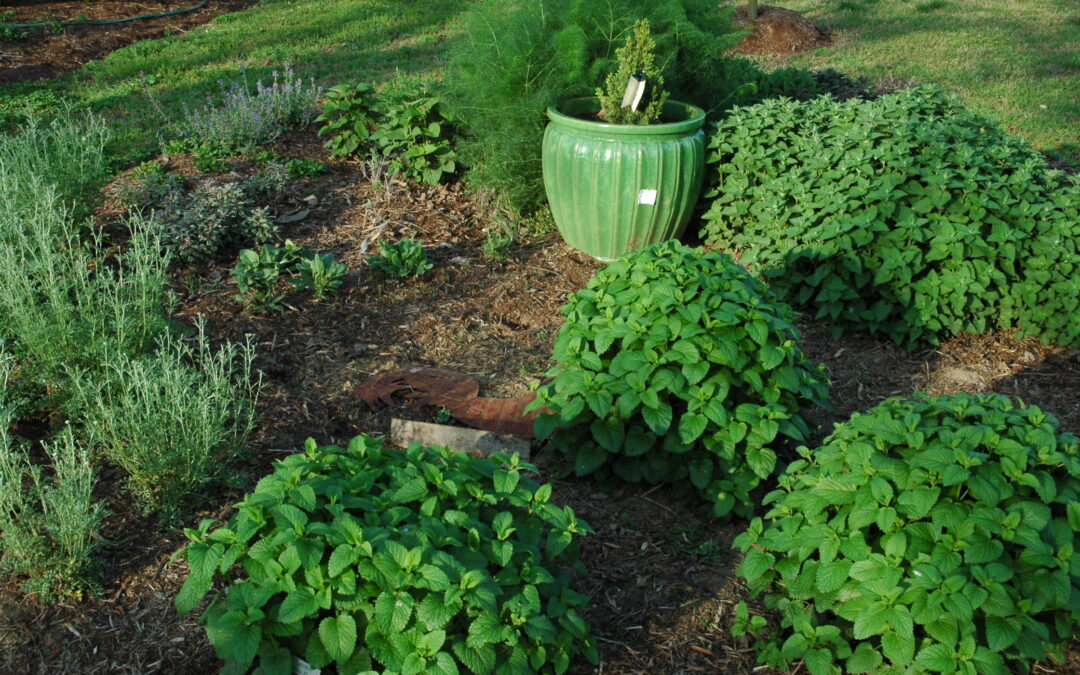
by Kenan White | Jan 20, 2014 | Miscellaneous |
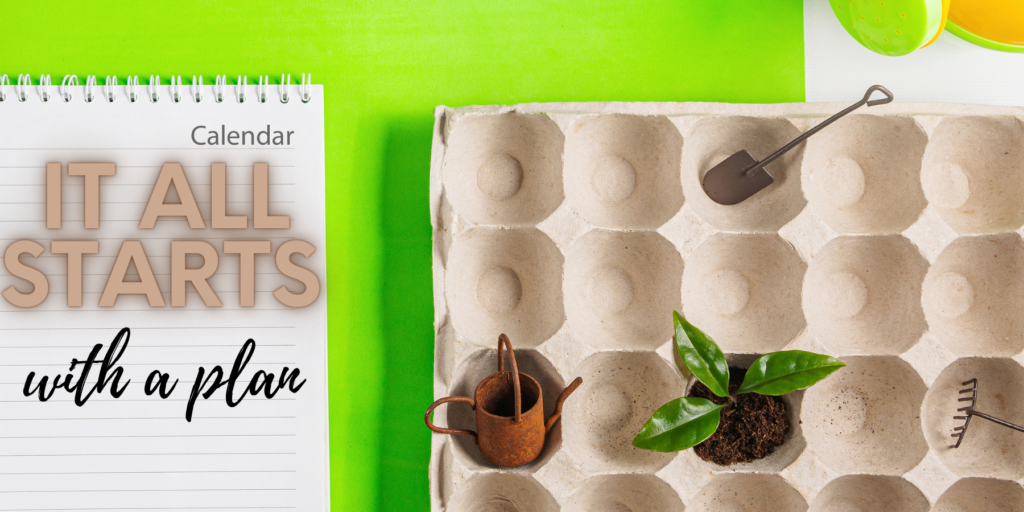
Do you need some encourage-mint? Don’t worry we are here to help! During these dark cold nights. Sitting planning your spring garden with your eyes close imagining the sun on your face, what’s a better way to help with the winter blues.
Herb gardening in January is all about planning. Whether you are working on your 30th herb garden, or you are working on your very first one, a good plan is an important first step. And, it doesn’t have to be a daunting task, but rather an enjoyable pastime that will ensure a bountiful spring garden.
If you are a new gardener, then this might be your chance to start from scratch in the gardener world. Perhaps you’ve had a browse on sites for a new patio, or you have had a peruse online for outdoor furniture. Well a garden isn’t a garden without some sort of foliage. And a herb garden is a way to really add some natural vibes and some character to your garden. And, since you can make your garden full of herbs you love to use in the kitchen. You can create an Culinary herb garden that can be planted anywhere in your garden: plant them under an ornamental tree, among your vegetables, or in containers. The larger herbs make perfect landscape plants. Using herbs in you garden you can even create a informal garden of culinary herbs planted as a curving border. This particular plan can also be treated as an island, accessible on all sides.
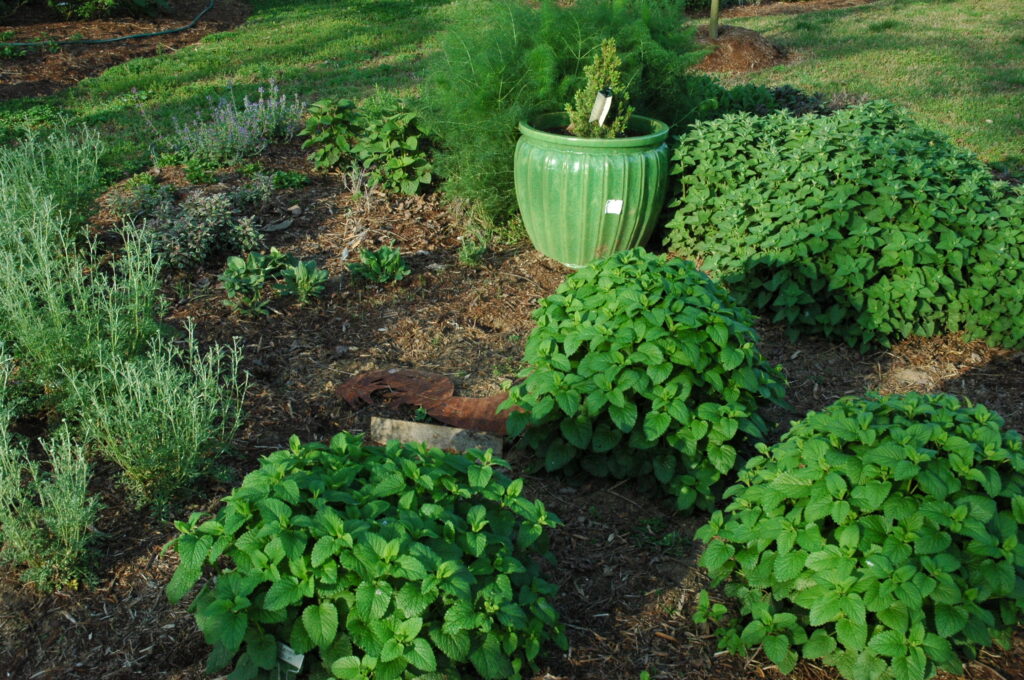
Here is a sample of an “herb garden island”, access your garden for all sides!
First, determine where the garden is going and how much space you are going to need. The shape and size can be adapted to the specifics of your site, and once you’re determined placement use a hose to lay out the curve of the border. No straight lines allowed! Even a slight curve will make for a more interesting bed. If this is an established bed, then a lot of the work has been done. If you are creating a new bed, don’t worry. As long as your ground is not frozen, you can get out there and dig. Make sure that you prepare your soil (a Google search on “preparing a garden” will provide you with more than enough information). When deciding where to put what, my only advice is this: everything can be moved. There are no hard and fast rules. A few things to remember – put your low growers in the front of the bed, make sure you pay attention to the MAX height and spread information on the plant product page and grow what you like (although adding a few unknowns keeps things interesting). And, above all else, use them regularly. This is also a perfect time to read and learn about your herbs. What sunlight they need, how much watering…and most herbs have multiple purposes other than just culinary!
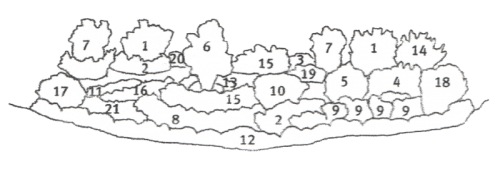
We created a sample here to show how simple it can be. It doesn’t need to be fancy or you can let your creativity run wild!
1 – Dill 2 – Calendula 3 – Vietnamese Coriander 4 – Cilantro 5 – Bronze Fennel 6 – Bay Laurel
7 – Rosemary ‘Arp’ 8 – Basil Genovese 9 – Sweet Marjoram 10 – Curly Parsley
11 – Cutting Celery 12 – Low Growers: Thyme Plants 13 – Italian Parsley 14 – Rosemary ‘Tuscan Blue’
15 – Sage ‘Common’ 16 – Purple Sage 17 – Green Fennel 18 – Savory 19 – Tagetes 20 – Tarragon 21 – Italian Oregano
by Kenan White | Oct 9, 2012 | A Year in the Life.., Basics, Gardening, Growing, Herbs, Miscellaneous |
I am published in Fine Gardening magazine…
It all started with questions I was getting from customers about growing outdoor herbs in the winter. Because we strive to provide an exchange of information for all types of growers, I was more than happy to help. Fine Gardening was getting the same questions from their readers that we were getting from our customers, so they picked up my article and used it in their December 2012 edition to help reach more growers who were having the same questions.
A Strategy for Maintaining Fresh Herbs in Winter
Here are a few tips to help you winter over your favorite herbs:
3 reasons to bring your herbs indoors:
- Keep the herbs alive to get more months of enjoyment
- Enjoy fresh flavor for all of your hearty winter dishes.
- To keep tender plants over-winter for spring planting
When to bring herbs indoors: Two weeks before the first hard frost, typically mid-Sept to mid-October
How to repot:
- Choose the healthiest plants and compost the others.
- Clean soil of debris and weeds
- Dig plants carefully, saving a generous root ball.
- Repot into containers 2” wider and deeper than the root ball using fresh potting soil
- Thoroughly water newly potted plants
- Leave plants outside for a few days to acclimate to their new containers.
Indoor Care Tips:
- Choose a sunny location with 6-8 hours of direct sun.
- Consider temperature and humidity. Don’t place them where they will dry out quickly or be in a cold, drafty spot.
- Typically herbs don’t need a lot of water. Check soil by sticking your finger about a half inch in to test for moisture.
- Room temp should not go below 50 degrees
- Let the plants rest before harvesting
- Don’t be alarmed if your herb plants lose their lower leaves as this is the plant’s way of dealing with the change and getting rid of leaves that no longer produce enough food. Lemon Verbena is especially likely to do this.
Which herbs will work best indoors?
- Tender perennials: Bay, Lemon Verbena, Lemon Grass
- Biennial herbs: parsley
- Annual herbs: cilantro, arugula,
Dormancy requirements make some plants better choices.
- Unless you want to add grow lights, avoid plants that go dormant like mint
- Hardy perennials are best left outdoors. Rosemary, Lavender, Mint
6 plants to keep for winter then return to garden in spring:
6 plants that are used for extended harvest.
Replanting your herbs for Spring:
After the last frost, usually late April or early May, start placing potted herbs outside during the day so they get accustomed to a new climate. Keep an eye on night temperatures. Begin to leave them out when night temperatures are above 50F.
- Plants should have been pruned in winter. Trim stray stems to keep plants bushy
- Replant in mid-May
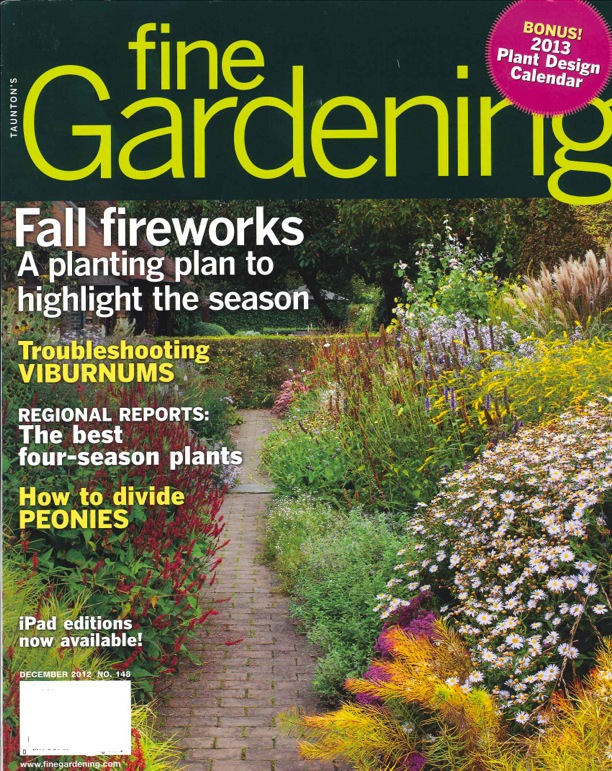
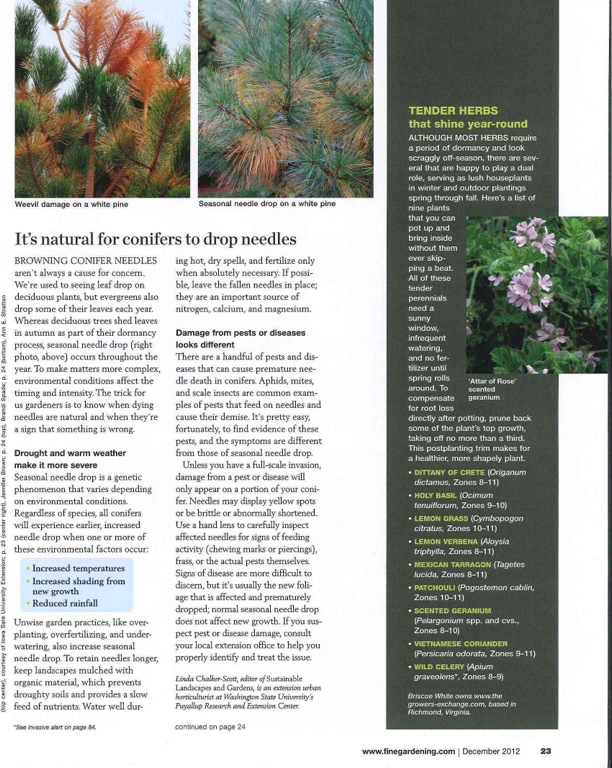
by Kenan White | Oct 1, 2012 | A Year in the Life.., Exploring, Gardening, Growing, Herbs, Miscellaneous, Wildlife |
Chamomile a weed? One person’s weed is another person’s herb!
While on a trip to Prairie Canada, I was surprised to find find common chamomile blooming among the prairie plants. After first spotting this familiar herb, I began seeing it along the road shoulder, in fields of peas and beans, and even in the lawn where I was staying. From my host, I learned that on the prairie farmers consider chamomile a noxious weed and work hard trying to eliminate it from their crops fields. This is a good example for comparing a desirable herb plant from a weed. And as the description for weeds explains; it all depends on where a plant is growing! So even though chamomile is a weed is some places, it is a welcome herb in my garden. I have plenty of other plants on my own weed list!
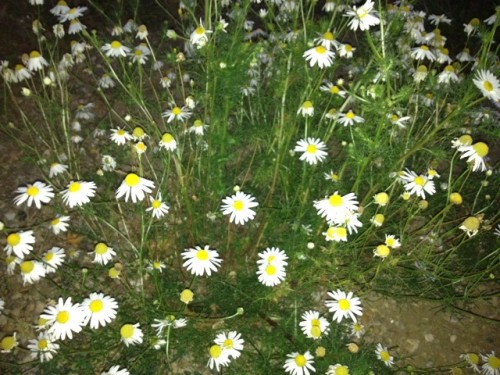
by Kenan White | Sep 11, 2012 | Miscellaneous |
As summer fades into fall, we begin to notice the little signs warning that winter is approaching; even if still weeks away. Some signs are easier to read than others. Are the tree leaves turning early or are they just exhausted from a hot dry summer? Does that wooly bear caterpillar have a wide stripe or not? One sure sign that leaves no room for doubt is the Joe Pye Weed. The story says that Joe Pye was a Native American healer who saved a community of settlers from a sickness using the plant that now carries his name as the cure.
Even though Joe Pye Weed is rarely used for medicinal purposes these days, the plant can still perform an important function for those that notice it. For me, Joe Pye blooming is the grand finale to summer. Joe Pye always waits to the end, so when you see it’s purple blooms, summer is just about over! Though there may be a few warm days ahead, it is time to start preparing for the coming winter. Joe Pye says so, and he never lies!
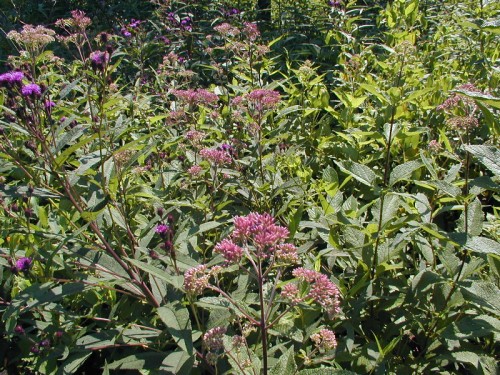
Joe Pye Weed
 g since I first put seed to soil in mid March. You name it, I’ve tried it : Diatomaceous Earth, Rotonone Powder, Pyrethrum Spray … even the time consuming and not so pleasurable task of hand picking these creatures off of my squash leaves. I’ve read articles, researched remedies and honestly, felt a lot of stress that is not a usual part of my post-spring mentality. This ‘war’ runs against all of the reasons that I love growing plants; growing puts me back in touch with the natural rhythms and harmony of the natural world. I like working WITH nature, not against it. But, this is an on-going war and I refuse to surrender.
g since I first put seed to soil in mid March. You name it, I’ve tried it : Diatomaceous Earth, Rotonone Powder, Pyrethrum Spray … even the time consuming and not so pleasurable task of hand picking these creatures off of my squash leaves. I’ve read articles, researched remedies and honestly, felt a lot of stress that is not a usual part of my post-spring mentality. This ‘war’ runs against all of the reasons that I love growing plants; growing puts me back in touch with the natural rhythms and harmony of the natural world. I like working WITH nature, not against it. But, this is an on-going war and I refuse to surrender.









